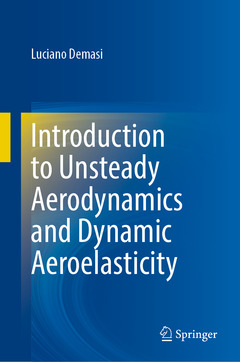Description
Introduction to Unsteady Aerodynamics and Dynamic Aeroelasticity, 1st ed. 2024
Author: Demasi Luciano
Language: English
Subjects for Introduction to Unsteady Aerodynamics and Dynamic...:
450 p. · 15.5x23.5 cm · Hardback
Description
/li>Contents
/li>Biography
/li>Comment
/li>
Aeroelasticity is an essential discipline for the design of airplanes, unmanned systems, and innovative configurations.
This book introduces the subject of unsteady aerodynamics and dynamic aeroelasticity by presenting industry-standard techniques, such as the Doublet Lattice Method for nonplanar wing systems. ?Introduction to Unsteady Aerodynamics and Dynamic Aeroelasticity'' is a useful reference for aerospace engineers and users of NASTRAN and ZAERO but is also an excellent complementary textbook for senior undergraduate and graduate students.
The theoretical material includes:
· Fundamental equations of aerodynamics.
· Concepts of Velocity and Acceleration Potentials.
· Theory of small perturbations.
· Virtual displacements and work, Hamilton's Principle, and Lagrange's Equations.
· Aeroelastic equations expressed in the time, Laplace, and Fourier domains.
· Concept of Generalized Aerodynamic Force Matrix.
· Complete derivation of the nonplanar kernel for unsteady aerodynamic analyses.
· Detailed derivation of the Doublet Lattice Method.
· Linear Time-Invariant systems and stability analysis.
· Rational function approximation for the generalized aerodynamic force matrix.
· Fluid-structure boundary conditions and splining.
· Root locus technique.
· Techniques to find the flutter point: k, k-E, p-k, non-iterative p-k, g, second-order g, GAAM, p, p-L, p-p, and CV methods.
Dr. Luciano Demasi is Professor of Aerospace Engineering, San Diego State University, San Diego, CA. He received the “Outstanding Contribution to Aerospace Research (2023)” award from the American Institute of Aeronautics and Astronautics (AIAA) and is an AIAA associate fellow.
Luciano Demasi is ranked in top 2% of authors worldwide over a total of 55,422 researchers and published more than 100 articles in the areas of aerodynamics, structures, and aeroelasticity.
These books may interest you

Principles of Aeroelasticity 93.24 €



